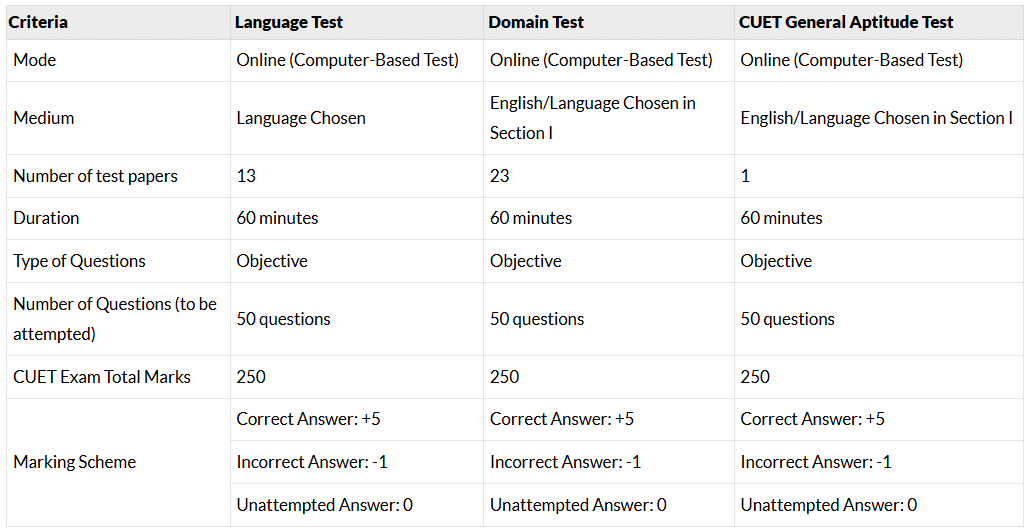CUET Exam Pattern & Syllabus | Important Updates & Notifications for CUET PDF Download
The CUET 2026 exam pattern has been updated. The NTA has made changes to the CUET UG exam, including the duration, mode of examination, and the number of subjects. The exam will return to the Computer-Based Test (CBT) format.
- CUET UG will consist of three sections:
- Section 1: 13 languages
- Section 2: 23 domain subjects
- Section 3: General Aptitude Test

The CUET UG 2026 will have three parts with objective-type Multiple Choice Questions (MCQs). The question paper will be in English and the chosen regional languages from a selection of 12. Each question will be worth five marks, and there will be a negative marking of one mark for each incorrect answer. Candidates can choose up to five subjects. Students can opt for any CUET subject, regardless of what they studied in class 12th. The CUET 2026 exam date has been announced to take place between May 08 and June 01, 2026.
CUET Exam Overview
The CUET UG 2026 exam will consist of three sections:
Section 1: Language Paper (13 Languages)
Section 2: Domain Paper (23 Subjects)
Section 3: General Aptitude Test
Each section will be computer-based (Online CBT), and all the questions will be objective-type Multiple Choice Questions (MCQs). Candidates can select up to five subjects, including one or two language papers and domain papers, based on their choice.

CUET Exam Pattern
This exam is divided into 3 sections: Language Paper (1A and 1B), Domain Paper, and General Aptitude Test. The table below will provide helpful information about how NTA will design the CUET exam pattern for the 2026 question paper.
CUET Exam Pattern 2025 | |||
|---|---|---|---|
Sections | Subjects/ Tests | No. of Questions | To be Attempted |
Section IA | 13 Languages | 50 | 40 |
Section IB | 19 Languages | ||
Section II | 27 | 45/50 | 35/40 |
Section III | General Test | 60 | 50 |
The general difficulty level of the CUET exam is found to be from an easy to moderate level as it is solely based on the NCERT syllabus of class 12 for domain-specific subjects.
Now, let us have a look at the detailed syllabus and subject list for the CUET exam.
CUET UG 2026 Exam Pattern Breakdown

Marking Scheme:
Correct Answer: +5 marks
Incorrect Answer: -1 mark
Unattempted: 0 marks
Subjects Overview
Language Paper (Section 1)
Candidates can choose from 13 Indian languages (English, Hindi, Bengali, Tamil, Urdu, etc.) and will be tested on reading comprehension, vocabulary, and grammar.
Domain Paper (Section 2)
The domain-specific test includes 23 subjects such as Physics, Chemistry, Mathematics, Economics, Political Science, History, Psychology, etc., based on the NCERT Class 12 syllabus.
General Aptitude Test (Section 3)
This section will cover:
General Knowledge (National & International)
Current Affairs
Mental Ability (Verbal & Non-verbal reasoning)
Numerical Ability (Basic mathematical operations)
Quantitative Reasoning
Logical & Analytical Reasoning
Key Changes for CUET UG 2026
Language Papers: The 13 Indian languages and foreign languages (like French, German, etc.) will have proficiency tests based on comprehension and vocabulary.
Domain Papers: The inclusion of 23 domain subjects, but some subjects like Entrepreneurship, Teaching Aptitude, and Fashion Studies are discontinued.
General Test: This is an optional exam but may be required for certain universities and courses. It assesses general knowledge, reasoning, and basic arithmetic skills.
Exam Slots: CUET UG 2026 will be conducted across multiple slots from May 08 to June 01, 2026.
CUET Exam Structure
- Section 1A (Language Paper): Choose 1-2 languages.
- Section 1B (Optional Languages): Choose from a list of foreign languages.
- Section 2 (Domain-Specific Subjects): Choose 2-3 domain subjects from the list.
- Section 3 (General Aptitude Test): Optional, but may be required for certain courses.
CUET Syllabus 2026
This year, the National Testing Agency (NTA) will conduct the Central Universities Entrance Test (CUET) in 13 different languages, including English, Hindi, Assamese, Bengali, Gujarati, Kannada, Malayalam, Marathi, Odia, Tamil, Telugu, Urdu, and Punjabi. Additionally, NTA has decided to shift from the traditional offline format to an online Computer Based Test for this year's CUET Exam. To provide candidates with a clear understanding of the CUET Exam and its marking scheme, we have outlined an overview in the table below.
CUET Syllabus 2026 Overview | ||
Syllabus | Language | Language to be tested through:
|
Domain Subjects | A total of 27 Subjects based on their Class 12 syllabus. | |
General test |
| |
Note: For Section 1A, there are 13 different languages. Any of these languages may be chosen and for Section 1B, there are 20 Languages. Any of these languages may be chosen. The list of these is given below:
(1) Language Test Subject
- English
- Tamil
- Telugu
- Kannada
- Malayalam
- Marathi
- Gujarati
- Odia
- Bengali
- Assamese
- Punjabi
- Hindi
- Urdu
(2) Optional Language Subjects
- French
- Spanish
- German
- Nepali
- Persian
- Italian
- Arabic
- Sindhi
- Kashmiri
- Konkani
- Bodo
- Dogri
- Maithili
- Manipuri
- Santhali
- Tibetan
- Japanese
- Russian
- Chinese
As English is chosen by most of the candidates, To prepare effectively for the CUET 2026 , candidates must be familiar with the English syllabus. The following is a comprehensive, unit-wise CUET English Syllabus that will help candidates design a well-structured preparation strategy based on the most important topics:
1. Reading Comprehension: Two or three passages that may be narrative, factual, or literary.
2. Verbal Ability
3. Jumbled words
4. Choosing the correct word
5. Synonyms and antonyms
6. Vocabulary
CUET Domain Wise Syllabus:
There are 27 Domains specific subjects being offered under this section. A candidate may choose any subject as desired by the applicable University/ Universities. The detailed syllabus of each domain is available below:
- Accountancy
- Biology/ Biological Studies/ Biotechnology/Biochemistry
- Business Studies
- Chemistry
- Computer Science/ Informatics Practices
- Economics/ Business Economics
- Engineering Graphics
- Entrepreneurship
- Geography/Geology
- History
- Home Science
- Knowledge Tradition - Practices in India
- Legal Studies
- Environmental Science
- Mathematics
- Physical Education/ NCC /Yoga
- Physics
- Political Science
- Psychology
- Sociology
- Teaching Aptitude
- Agriculture
- Mass Media/ Mass Communication
- Anthropology
- Art Education Sculpture
- Environmental Studies
- Performing Arts
CUET General Test Syllabus
It is crucial for candidates preparing for the CUET Exam 2026 to understand the CUET General Test syllabus. The test will cover the following topics: General Knowledge, Current Affairs, General Mental Ability, Numerical Ability, Quantitative Reasoning, and Logical & Analytical Reasoning. Detailed syllabi for each section are provided in the table below.
Sections | Detailed Syllabus |
| |
| |
Numerical Ability (Till Grade 8) | |
Now, let us have a look at some of the best books from which you can prepare for the CUET 2026 Exam.
CUET Preparation Books
Here is a list of the top resources to help you prepare for the CUET Exam:
NCERT Books for each domain subject (if available): The NCERT books are designed to cover the core topics in each domain subject and can help you build a strong foundation in language skills. Make sure to check for the availability of Class 12 NCERT books in the language you have chosen for the CUET exam.
1. Practice sets and Mock Tests: The full-length mock tests and subject-wise practice tests by EduRev will help you improve your language skills and familiarize yourself with the exam format. You can check out the various Practice and Mock Tests from the below-given links.
CUET Study Material | |
2. Check Past Year Papers: Referring to past year papers of CUET can provide you with valuable insights into the types of questions asked in the CUET Section 1 exam. Analyzing these papers will help you understand the exam pattern, question types, and difficulty level, allowing you to strategize your preparation accordingly.
3. NCERT Exemplar for each domain subject (if available): The NCERT Exemplar series is another valuable resource for CUET Section 1 preparation. These books offer additional practice questions and serve as an extension to the NCERT textbooks which include various types of questions. Make sure to check for the availability of NCERT Exemplar books in the language you have chosen for the CUET exam.
For a complete list of the Best Books for CUET preparation, check out this EduRev article which provides you with a section-wise and domain-wise list of books for CUET Exam preparation.
CUET Exam Preparation Tips
The CUET Exam Syllabus is not as difficult as JEE Mains and can be cracked if students have the potential, willpower, and basic science concepts are clear. Students should start preparing for the CUET Exam from Class 12 or after the Board Exams. Aspirants must follow these prep strategies to optimize their CUET preparation.
1. Understand the CUET Syllabus and Exam Pattern
Begin by thoroughly studying the syllabus and exam pattern. Plan your study schedule on a monthly, weekly, and daily basis. Identify the essential topics and segregate them into easy and difficult categories based on your personal experience. Analyze previous year's question papers to understand the topics with maximum weightage. Checkout CUET Exam pattern and Syllabus from here.
2. Invest in Proper Preparation Books
Purchase at least two to three prep books specifically tailored for the CUET exam based on the course you are applying for. These books will help you determine which topics to focus on and what to expect in the entrance exam. For a complete list of the Best Books for CUET preparation, check out this EduRev article which provides you with a section-wise and domain-wise list of books for CUET Exam preparation.
3. Develop a Personalized Timetable
Create a timetable that prioritizes topics and subjects, and sets daily, weekly, and monthly goals. Allocate time for completing the CUET syllabus and revising the content. Attempt as many question papers, mock papers, and previous years' question papers as possible to better understand the exam expectations.
4. Analyze Past Year's Question Papers
Solve the past years’ paper and gain insight into the exam pattern and format of questions. Identify subjects and topics that are given high importance, enabling you to focus on areas that can help you score better in the exam.
5. Practice with Sample Papers and Mock Tests
Regularly solve sample papers and mock tests to identify your strengths and weaknesses. This practice will also help you develop the best approach for attempting the actual CUET question paper, improve time management, and familiarize yourself with the paper format.
EduRev provides you with section-wise and domain-wise mock tests which you can check out from the below table.
CUET Mock Tests and Study Material | |
In conclusion, preparing for the CUET exam requires a strategic approach and consistent effort. Understand the syllabus and exam pattern, invest in proper preparation books, develop a personalized timetable, analyze past year's question papers, and practice with sample papers and mock tests to optimize your preparation and increase your chances of success in the CUET exam.
How to Prepare for CUET Exam Using EduRev?
The EduRev’s package for CUET is available in three categories for commerce, science and humanities students along with various partner courses. Let us take a look at what all EduRev offers:
- Category-Wise tests: EduRev offers 100+ category-wise practice tests for various subjects of the CUET exam. These categories are broadly divided into commerce, humanities and science.
- Domain-Wise Practice Tests: In each Category Package, you will have access to their domain-wise practice tests which are broadly divided into 100+ chapter-wise tests which reduce your hassle of buying multiple books for each domain.
- CUET Mock Tests: 100+ full-length and domain-wise practice mock tests are also provided by EduRev which are as per the CUET standards from which you can practice regularly to track your performance.
- CUET English Preparation: EduRev’s Course for CUET English Language Preparation covers each and every topic of the official syllabus which includes video lectures, notes and tests for Reading Comprehension, Vocabulary, Synonyms and Antonyms, Selecting Words and Ordering of Sentences.
- CUET General test Preparation: EduRev’s Course for CUET General Test Preparation covers each and every topic of the official syllabus which includes video lectures, notes and tests for General Knowledge, Current Affairs, General Mental Ability and Logical Reasoning, Numerical Ability and Quantitative Reasoning.
- Course Analyzer: EduRev also provides a course analyzer which gives you the total progress, areas of strength and weakness along with each test’s analysis






















